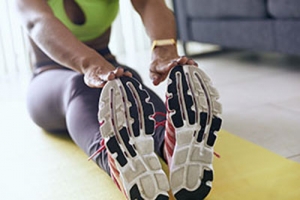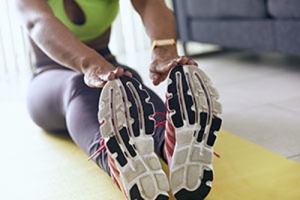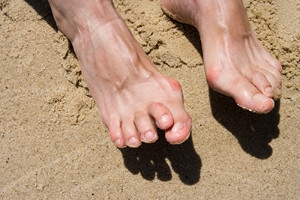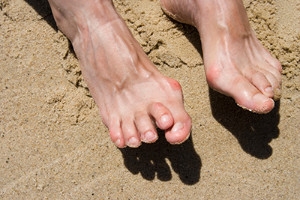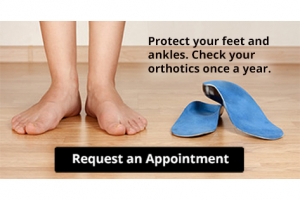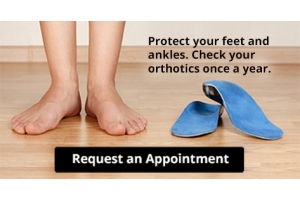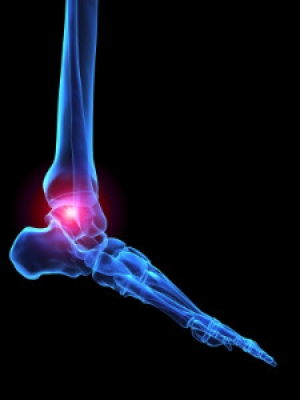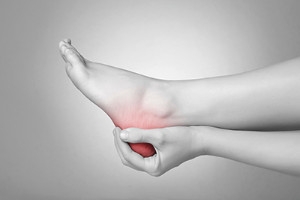Items filtered by date: June 2020
What Causes Cracked Heels?
The uncomfortable condition that is known as cracked heels can cause difficulty in walking and wearing shoes. They are described as deep cracks, or fissures in the heel of the foot, and bleeding may occur in severe cases. There are several reasons why this condition may develop. These can include frequently wearing shoes that have an open back, or standing for long periods of time. Additionally, existing medical conditions such as psoriasis or eczema may cause the skin to become dry, and cracked heels may develop. Research has indicated it may be beneficial to drink plenty of water, as this may help the body to stay hydrated. If you notice your heels are dry, it is suggested that you seek the counsel of a podiatrist who can recommend the best treatment options for cracked heels.
Cracked heels are unsightly and can cause further damage to your shoes and feet. If you have any concerns, contact Dr. Kenneth Donovan from Advanced Care Foot and Ankle. Our doctor can provide the care you need to keep you pain-free and on your feet.
Cracked Heels
Cracked heels appear unappealing and can make it harder for you walk around in sandals. Aside from looking unpleasant, cracked heels can also tear stockings, socks, and wear out your shoes. There are several methods to help restore a cracked heel and prevent further damage.
How Do You Get Them?
Dry skin is the number one culprit in creating cracked heels. Many athletes, walkers, joggers, and even swimmers suffer from cracked heels. Age and skin oil production play a role to getting cracked heels as well.
Promote Healing
Over the counter medicines can help, especially for those that need instant relief or who suffer from chronic dry feet.
Wear Socks – Wearing socks with medicated creams helps lock in moisture.
Moisturizers – Applying both day and night will help alleviate dryness which causes cracking.
Pumice Stones – These exfoliate and remove dead skin, which allows for smoother moisturizer application and better absorption into the skin.
Eating healthy with a well-balanced diet will give the skin a fresh and radiant look. Your body responds to the kinds of food you ingest. Omega-3 fatty acids and zinc supplements can also revitalize skin tissue.
Most importantly, seek professional help if unsure how to proceed in treating cracked heels.
What Causes Cracked Heels?
 The uncomfortable condition that is known as cracked heels can cause difficulty in walking and wearing shoes. They are described as deep cracks, or fissures in the heel of the foot, and bleeding may occur in severe cases. There are several reasons why this condition may develop. These can include frequently wearing shoes that have an open back, or standing for long periods of time. Additionally, existing medical conditions such as psoriasis or eczema may cause the skin to become dry, and cracked heels may develop. Research has indicated it may be beneficial to drink plenty of water, as this may help the body to stay hydrated. If you notice your heels are dry, it is suggested that you seek the counsel of a podiatrist who can recommend the best treatment options for cracked heels.
The uncomfortable condition that is known as cracked heels can cause difficulty in walking and wearing shoes. They are described as deep cracks, or fissures in the heel of the foot, and bleeding may occur in severe cases. There are several reasons why this condition may develop. These can include frequently wearing shoes that have an open back, or standing for long periods of time. Additionally, existing medical conditions such as psoriasis or eczema may cause the skin to become dry, and cracked heels may develop. Research has indicated it may be beneficial to drink plenty of water, as this may help the body to stay hydrated. If you notice your heels are dry, it is suggested that you seek the counsel of a podiatrist who can recommend the best treatment options for cracked heels.
Cracked heels are unsightly and can cause further damage to your shoes and feet. If you have any concerns, contact Dr. Kenneth Donovan from Advanced Care Foot and Ankle. Our doctor can provide the care you need to keep you pain-free and on your feet.
Cracked Heels
Cracked heels appear unappealing and can make it harder for you walk around in sandals. Aside from looking unpleasant, cracked heels can also tear stockings, socks, and wear out your shoes. There are several methods to help restore a cracked heel and prevent further damage.
How Do You Get Them?
Dry skin is the number one culprit in creating cracked heels. Many athletes, walkers, joggers, and even swimmers suffer from cracked heels. Age and skin oil production play a role to getting cracked heels as well.
Promote Healing
Over the counter medicines can help, especially for those that need instant relief or who suffer from chronic dry feet.
Wear Socks – Wearing socks with medicated creams helps lock in moisture.
Moisturizers – Applying both day and night will help alleviate dryness which causes cracking.
Pumice Stones – These exfoliate and remove dead skin, which allows for smoother moisturizer application and better absorption into the skin.
Change in Diet
Eating healthy with a well-balanced diet will give the skin a fresh and radiant look. Your body responds to the kinds of food you ingest. Omega-3 fatty acids and zinc supplements can also revitalize skin tissue.
Most importantly, seek professional help if unsure how to proceed in treating cracked heels. A podiatrist will help you with any questions or information needed.
If you have any questions, please feel free to contact one of our offices located in Warren, Livingston, and Toms River, NJ . We offer the newest diagnostic and treatment technologies for all your foot care needs.
Types of Foot Surgery
There are many patients who have found it beneficial to have foot surgery performed to correct painful ailments. Common types of surgeries can include a bunionectomy, metatarsal, and heel surgery. A bunion is considered to be a deformity and can develop as a result of genetic factors or from wearing shoes that do not fit correctly. Metatarsal surgery may be effective in treating a broken toe that is dislocated. Additionally, heel pain may be indicative of the painful condition that is known as plantar fasciitis, and many patients choose to have this surgery to alleviate the pain. If you have any type of chronic foot pain, it is strongly advised that you consult with a podiatrist who can discuss surgery options with you. Foot surgery is sometimes necessary to treat a foot ailment. To learn more, contact Dr. Kenneth Donovan of Advanced Care Foot and Ankle. Our doctor will assist you with all of your foot and ankle needs.
When Is Surgery Necessary?
Foot and ankle surgery is generally reserved for cases in which less invasive, conservative procedures have failed to alleviate the problem. Some of the cases in which surgery may be necessary include:
- Removing foot deformities like bunions and bone spurs
- Severe arthritis that has caused bone issues
- Cosmetic reconstruction
What Types of Surgery Are There?
The type of surgery you receive will depend on the nature of the problem you have. Some of the possible surgeries include:
- Bunionectomy for painful bunions
- Surgical fusion for realignment of bones
- Neuropathy decompression surgery to treat nerve damage
Benefits of Surgery
Although surgery is usually a last resort, it can provide more complete pain relief compared to non-surgical methods and may allow you to finally resume full activity.
Surgical techniques have also become increasingly sophisticated. Techniques like endoscopic surgery allow for smaller incisions and faster recovery times.
If you have any questions please feel free to contact one of our offices located in Warren, Livingston, and Toms River, NJ . We offer the newest diagnostic and treatment technologies for all your foot and ankle needs.
How Does Hammertoe Occur?
The second and third toes may be impacted by the medical condition that is known as hammertoe. The toe bends at the joint in an upward position, and often resembles a hammer. It is considered to be a deformity, and in severe cases, surgery may be necessary to permanently straighten the toes.There are two stages of hammertoe. When this condition is first noticed, the joints can be flexible, and relief may be found when the correct shoes are worn. Additionally, there are specific stretches that can be performed which may help to strengthen the toes. When the condition becomes more severe, it is referred to as rigid hammertoe, and the joints are unable to move. A common reason why this condition may develop can consist of wearing shoes that do not have adequate room for the toes to move freely in. Additionally, genetic factors may lead to developing hammertoe. Please consult with a podiatrist who can properly diagnose this ailment, and suggest treatment options that are correct for you.
Hammertoes can be a painful condition to live with. For more information, contact Dr. Kenneth Donovan of Advanced Care Foot and Ankle. Our doctor will answer any of your foot- and ankle-related questions.
Hammertoe
Hammertoe is a foot deformity that occurs due to an imbalance in the muscles, tendons, or ligaments that normally hold the toe straight. It can be caused by the type of shoes you wear, your foot structure, trauma, and certain disease processes.
Symptoms
- Painful and/or difficult toe movement
- Swelling
- Joint stiffness
- Calluses/Corns
- Physical deformity
Risk Factors
- Age – The risk of hammertoe increases with age
- Sex – Women are more likely to have hammertoe compared to men
- Toe Length – You are more likely to develop hammertoe if your second toe is longer than your big toe
- Certain Diseases – Arthritis and diabetes may make you more likely to develop hammertoe
Treatment
If you have hammertoe, you should change into a more comfortable shoe that provides enough room for your toes. Exercises such as picking up marbles may strengthen and stretch your toe muscles. Nevertheless, it is important to seek assistance from a podiatrist in order to determine the severity of your hammertoe and see which treatment option will work best for you.
If you have any questions, please feel free to contact one of our offices located in Warren, Livingston, and Toms River, NJ . We offer the newest diagnostic and treatment technologies for all your foot care needs.
How Does Hammertoe Occur?
 The second and third toes may be impacted by the medical condition that is known as hammertoe. The toe bends at the joint in an upward position, and often resembles a hammer. It is considered to be a deformity, and in severe cases, surgery may be necessary to permanently straighten the toes.There are two stages of hammertoe. When this condition is first noticed, the joints can be flexible, and relief may be found when the correct shoes are worn. Additionally, there are specific stretches that can be performed which may help to strengthen the toes. When the condition becomes more severe, it is referred to as rigid hammertoe, and the joints are unable to move. A common reason why this condition may develop can consist of wearing shoes that do not have adequate room for the toes to move freely in. Additionally, genetic factors may lead to developing hammertoe. Please consult with a podiatrist who can properly diagnose this ailment, and suggest treatment options that are correct for you.
The second and third toes may be impacted by the medical condition that is known as hammertoe. The toe bends at the joint in an upward position, and often resembles a hammer. It is considered to be a deformity, and in severe cases, surgery may be necessary to permanently straighten the toes.There are two stages of hammertoe. When this condition is first noticed, the joints can be flexible, and relief may be found when the correct shoes are worn. Additionally, there are specific stretches that can be performed which may help to strengthen the toes. When the condition becomes more severe, it is referred to as rigid hammertoe, and the joints are unable to move. A common reason why this condition may develop can consist of wearing shoes that do not have adequate room for the toes to move freely in. Additionally, genetic factors may lead to developing hammertoe. Please consult with a podiatrist who can properly diagnose this ailment, and suggest treatment options that are correct for you.
Hammertoes can be a painful condition to live with. For more information, contact Dr. Kenneth Donovan of Advanced Care Foot and Ankle. Our doctor will answer any of your foot- and ankle-related questions.
Hammertoe
Hammertoe is a foot deformity that occurs due to an imbalance in the muscles, tendons, or ligaments that normally hold the toe straight. It can be caused by the type of shoes you wear, your foot structure, trauma, and certain disease processes.
Symptoms
- Painful and/or difficult toe movement
- Swelling
- Joint stiffness
- Calluses/Corns
- Physical deformity
Risk Factors
- Age – The risk of hammertoe increases with age
- Sex – Women are more likely to have hammertoe compared to men
- Toe Length – You are more likely to develop hammertoe if your second toe is longer than your big toe
- Certain Diseases – Arthritis and diabetes may make you more likely to develop hammertoe
Treatment
If you have hammertoe, you should change into a more comfortable shoe that provides enough room for your toes. Exercises such as picking up marbles may strengthen and stretch your toe muscles. Nevertheless, it is important to seek assistance from a podiatrist in order to determine the severity of your hammertoe and see which treatment option will work best for you.
If you have any questions, please feel free to contact one of our offices located in Warren, Livingston, and Toms River, NJ . We offer the newest diagnostic and treatment technologies for all your foot care needs.
Reminder: When Was the Last Time…?
Custom orthotics, or shoe inserts, should be periodically replaced. Orthotics must fit properly to give you the best results. Protect your feet and ankles!
Rheumatoid Arthritis and the Feet
Rheumatoid arthritis is an inflammatory form of arthritis that can create complications with the feet. This condition may cause swelling within the joints of the feet, making it very painful to complete daily tasks. Other symptoms include joint stiffness, fatigue, muscle pain, and numbness. Some risk factors for developing rheumatoid arthritis include genetics, bacteria and viruses, physical trauma, and obesity. In order to treat this condition, it may be beneficial to visit a doctor for prescribed medication, partake in physical therapy, and in more severe cases, surgery. It’s been said that having a well balanced diet may help relieve some of the symptoms associated with this condition. For a proper diagnosis and advised treatment plan, it’s suggested that you consult with a podiatrist for professional care.
Arthritis can be a difficult condition to live with. If you are seeking treatment, contact Dr. Kenneth Donovan from Advanced Care Foot and Ankle. Our doctor can provide the care you need to keep you pain-free and on your feet.
Arthritic Foot Care
Arthritis is a joint disorder that involves the inflammation of different joints in your body, such as those in your feet. Arthritis is often caused by a degenerative joint disease and causes mild to severe pain in all affected areas. In addition to this, swelling and stiffness in the affected joints can also be a common symptom of arthritis.
In many cases, wearing ill-fitting shoes can worsen the effects and pain of arthritis. Wearing shoes that have a lower heel and extra room can help your feet feel more comfortable. In cases of rheumatoid arthritis, the arch in your foot may become problematic. Buying shoes with proper arch support that contour to your feet can help immensely.
Alleviating Arthritic Pain
- Exercises that stretch the foot can prevent further pain and injury and increase mobility
- Most of the pain can be alleviated with anti-inflammatory drugs, heat, and topical medications
- Massages can help temporarily alleviate pain.
It is best to see your doctor for the treatment that is right for your needs and symptoms. Conditions vary, and a podiatrist can help you determine the right method of care for your feet.
If you have any questions, please feel free to contact one of our offices located in Warren, Livingston, and Toms River, NJ . We offer the newest diagnostic tools and technology to treat your foot and ankle needs.
Rheumatoid Arthritis and the Feet
 Rheumatoid arthritis is an inflammatory form of arthritis that can create complications with the feet. This condition may cause swelling within the joints of the feet, making it very painful to complete daily tasks. Other symptoms include joint stiffness, fatigue, muscle pain, and numbness. Some risk factors for developing rheumatoid arthritis include genetics, bacteria and viruses, physical trauma, and obesity. In order to treat this condition, it may be beneficial to visit a doctor for prescribed medication, partake in physical therapy, and in more severe cases, surgery. It’s been said that having a well balanced diet may help relieve some of the symptoms associated with this condition. For a proper diagnosis and advised treatment plan, it’s suggested that you consult with a podiatrist for professional care.
Rheumatoid arthritis is an inflammatory form of arthritis that can create complications with the feet. This condition may cause swelling within the joints of the feet, making it very painful to complete daily tasks. Other symptoms include joint stiffness, fatigue, muscle pain, and numbness. Some risk factors for developing rheumatoid arthritis include genetics, bacteria and viruses, physical trauma, and obesity. In order to treat this condition, it may be beneficial to visit a doctor for prescribed medication, partake in physical therapy, and in more severe cases, surgery. It’s been said that having a well balanced diet may help relieve some of the symptoms associated with this condition. For a proper diagnosis and advised treatment plan, it’s suggested that you consult with a podiatrist for professional care.
Arthritis can be a difficult condition to live with. If you are seeking treatment, contact Dr. Kenneth Donovan from Advanced Care Foot and Ankle. Our doctor can provide the care you need to keep you pain-free and on your feet.
Arthritic Foot Care
Arthritis is a joint disorder that involves the inflammation of different joints in your body, such as those in your feet. Arthritis is often caused by a degenerative joint disease and causes mild to severe pain in all affected areas. In addition to this, swelling and stiffness in the affected joints can also be a common symptom of arthritis.
In many cases, wearing ill-fitting shoes can worsen the effects and pain of arthritis. Wearing shoes that have a lower heel and extra room can help your feet feel more comfortable. In cases of rheumatoid arthritis, the arch in your foot may become problematic. Buying shoes with proper arch support that contour to your feet can help immensely.
Alleviating Arthritic Pain
- Exercises that stretch the foot can prevent further pain and injury and increase mobility
- Most of the pain can be alleviated with anti-inflammatory drugs, heat, and topical medications
- Massages can help temporarily alleviate pain.
It is best to see your doctor for the treatment that is right for your needs and symptoms. Conditions vary, and a podiatrist can help you determine the right method of care for your feet.
If you have any questions, please feel free to contact one of our offices located in Warren, Livingston, and Toms River, NJ . We offer the newest diagnostic tools and technology to treat your foot and ankle needs.
Common Symptoms of Plantar Fasciitis
The band of tissue that connects the heel bone to the toes is known as the plantar fascia. If this tissue becomes inflamed, it’s likely the foot condition known as plantar fasciitis may develop. Plantar fasciitis can cause a great deal of heel pain for those affected. Early detection and prompt treatment can be helpful for a speedy recovery. There are a few signs to look out for if you believe you may have developed plantar fasciitis. If you are experiencing pain when you first step out of bed in the morning, when seated or standing for prolonged periods of time, or going up and down stairs, you may have plantar fasciitis. For a proper diagnosis and suggested plan of treatment, it’s suggested that you consult with a podiatrist.
Plantar fasciitis can be very painful and inconvenient. If you are experiencing heel pain or symptoms of plantar fasciitis, contact Dr. Kenneth Donovan from Advanced Care Foot and Ankle. Our doctor can provide the care you need to keep you pain-free and on your feet.
What Is Plantar Fasciitis?
Plantar fasciitis is the inflammation of the thick band of tissue that runs along the bottom of your foot, known as the plantar fascia, and causes mild to severe heel pain.
What Causes Plantar Fasciitis?
- Excessive running
- Non-supportive shoes
- Overpronation
- Repeated stretching and tearing of the plantar fascia
How Can It Be Treated?
- Conservative measures – anti-inflammatories, ice packs, stretching exercises, physical therapy, orthotic devices
- Shockwave therapy – sound waves are sent to the affected area to facilitate healing and are usually used for chronic cases of plantar fasciitis
- Surgery – usually only used as a last resort when all else fails. The plantar fascia can be surgically detached from the heel
While very treatable, plantar fasciitis is definitely not something that should be ignored. Especially in severe cases, speaking to your doctor right away is highly recommended to avoid complications and severe heel pain. Your podiatrist can work with you to provide the appropriate treatment options tailored to your condition.
If you have any questions please feel free to contact one of our offices located in Warren, Livingston, and Toms River, NJ . We offer the newest diagnostic and treatment technologies for all your foot and ankle needs.
